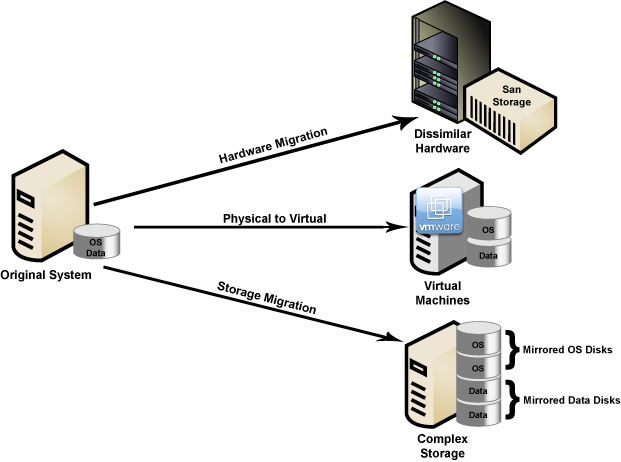Adaptable System Recovery
No backup plan is complete without the ability to restore the entire system.
Adaptable System Recovery

Disk Image vs. File-Level Backups
Historically, disaster recovery or bare-metal recovery backups were limited to disk images. This method of copying off the entire raw disk to a file is inefficient and completely inflexible. Restoring from a disk-image requires the recovery hardware and storage to be EXACTLY as it was before. Any minor change to the system hardware or disk geometry can prevent the system from booting. Maintaining duplicate hardware in case of a disaster is expensive and difficult over time. Many systems administrators are unaware that they need exact hardware until it is too late and waste valuable time searching eBay for replacement hardware that could be many years old.
File-level backups were good in that they only contain data and not unused disk space, however you could not perform a bare-metal recovery from a data backup. Disaster recovery often meant reinstalling the operating system, re-applying patches, re-installing third party applications, then restoring the data. The Recovery Time Objective (RTO) time could range from half-a-day to several days depending on the complexity of the system. Do you have a documented record of every update, patch and configuration applied to a system? Chances are some configurations will be lost in the process.
A Better Way
SBAdmin bridges this gap between disk-images and file-level backups with Adaptable System Recovery (ASR). ASR backups are file-level backups, but include the operating system as well as enough information about the storage configuration to rebuild your AIX, Solaris, or Linux systems from bare-metal. During the recovery process, the software will automatically detect changes in the hardware and make any changes necessary to ensure the system will be recovered successfully. Because we are rebuilding the system anyway, SBAdmin also provides the flexibility to make changes to the storage configuration as needed. Performing disaster recovery for Linux, AIX, and Solaris has never been easier or more flexible.
ASR provides greater flexibility for these tasks:
- Disaster Recovery from Bare-Metal
- Provisioning and Cloning
- Hardware Migration (including physical to virtual hardware)
- Storage Migration (RAID, LVM, ZFS, etc)
